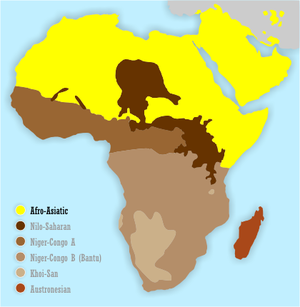اللغات الأفرو-آسيوية
| الأفرو آسيوية Afro-Asiatic | |
|---|---|
| التوزع الجغرافي | — |
| التبويب اللغوي | واحدة من العائلات اللغوية الكبرى بالعالم |
| التقسيمات | |
| ISO 639-2 / 5 | afa |
اللغات الأفروآسيوية (أي الحامية السامية) منتشرة في شمال أفريقيا، شرق أفريقيا، والشرق الأوسط، وتنقسم إلى:
ولغة عونغوتا نعتبر إحدى اللغات الأفروآسيوية، لكن دورها فيها لا يزال غير مؤكد.
كان العلماء يقسمونها بين فرعي اللغات السامية واللغات الحامية، لكن لا يعتبر ذالك الآن. فيبدو أن اللغات الأوموتية هي الأبعد عن اللغات الأخرى في المفردات والنحو، وكل اللغات الأخرى فرع آخر.
السمات المشركة
السمات المشتركة للغات الأفروآسيوية تتضمن:
- a two-gender system in the singular, with the feminine marked by the /t/ sound,
- VSO typology with SVO tendencies,
- a set of emphatic consonants, variously realized as glottalized, pharyngealized, or implosive, and
- a templatic morphology in which words inflect by internal changes as well as with prefixes and suffixes.
In the verbal system, Semitic, Berber, and Cushitic (including Beja) all provide evidence for a prefix conjugation:
| الإنجليزية | العربية (سامية) | قبيلي (بربر) | صومالي (كوشية) | بجا (الفعل هو "وَصـَلَ") |
| he dies | يموت | يـِموت | wudimta | iktim |
| she dies | tamuutu | temmut | wedimata | tiktim |
| they (m.) die | yamuutuuna | mmuten | wedimtan | iktimna |
| you (m. sg.) die | tamuutu | temmuteḍ | wadimate | tiktima |
| you (m. pl.) die | tamuutuuna | temmutem | wadimatan | tiktimna |
| I die | ˀamuutu | mmuteɣ | wadimta | aktim |
| we die | namuutu | nemmut | wadimana | niktim |
All Afro-Asiatic subfamilies show evidence of a causative affix s, but a similar suffix also appears in other groups, such as the Niger-Congo languages.
Semitic, Berber, Cushitic (including Beja), and Chadic support possessive suffixes.
Tonal languages appear in the Omotic, Chadic, and Cushitic branches of Afro-Asiatic, according to Ehret (1996). The Semitic, Berber, and Egyptian branches do not use tones phonemically.
Cognates
Some sample Afro-Asiatic cognates:
- b-n- 'build' (Ehret: *bĭn), attested in Chadic, Semitic (*bny), Cushitic (*mĭn/*măn 'house'), Berber (*bn) and Omotic (Dime bin- 'build, create').
- m-t 'die' (Ehret: *maaw), attested in Chadic (for example, Hausa mutu), Egyptian (mwt *muwt, mt, Coptic mu), Berber (mmet, pr. yemmut), Semitic (*mwt), and Cushitic (Proto-Somali *umaaw/*-am-w(t)- 'die'). Also Mot, Canaanite god of death. (The Proto-Indo-European root *mor-/mr- 'die' is similar, evidence in favor of the classification of both Afro-Asiatic and Indo-European in the hypothetical Nostratic family.)
- s-n 'know', attested in Chadic, Berber, and Egyptian.
- l-s 'tongue' (Ehret: *lis' 'to lick'), attested in Semitic (*lasaan/lisaan), Egyptian (ns *ls, Coptic las), Berber (ils), Chadic (for example, Hausa harshe), and possibly Omotic (Dime lits'- 'lick').
- s-m 'name' (Ehret: *sŭm / *sĭm), attested in Semitic (*sm), Berber (ism), Chadic (for example, Hausa suna), Cushitic, and Omotic (though some see the Berber form, ism, and the Omotic form, sunts, as Semitic loanwords.) The Egyptian smi 'report, announce' offers another possible cognate.
- d-m 'blood' (Ehret: *dîm / *dâm), attested in Berber (idammen), Semitic (*dam), Chadic, and arguably Omotic. Compare Cushitic *dîm/*dâm, 'red'.
انظر أيضاً
ببليوجرافيا أصول الكلمات
Some of the main sources for Afro-Asiatic etymologies include:
- Cohen, Marcel. 1947. Essai comparatif sur le vocabulaire et la phonétique du chamito-sémitique. Paris: Champion.
- Diakonoff, Igor M. et al. 1993-1997. "Historical-comparative vocabulary of Afrasian", St. Petersburg Journal of African Studies 2-6.
- Ehret, Christopher. 1996. Reconstructing Proto-Afroasiatic (Proto-Afrasian): Vowels, Tone, Consonants, and Vocabulary (University of California Publications in Linguistics 126). Berkeley, California.
- Orel, Vladimir E. and Olga V. Stolbova. 1995. Hamito-Semitic Etymological Dictionary: Materials for a Reconstruction. Leiden: Brill. ISBN 90-04-10051-2.[1]
المصادر
المراجع
- Barnett, William and John Hoopes (editors). 1995. The Emergence of Pottery. Washington, DC: Smithsonian Institution Press. ISBN 1-56098-517-8
- Bender, Lionel et al. 2003. Selected Comparative-Historical Afro-Asiatic Studies in Memory of Igor M. Diakonoff. LINCOM.
- Bomhard, Alan R. 1996. Indo-European and the Nostratic Hypothesis. Signum.
- Ehret, Christopher. 1997. Abstract of "The lessons of deep-time historical-comparative reconstruction in Afroasiatic: reflections on Reconstructing Proto-Afroasiatic: Vowels, Tone, Consonants, and Vocabulary (U.C. Press, 1995)", paper delivered at the Twenty-fifth Annual Meeting of the North American Conference on Afro-Asiatic Linguistics, held in Miami, Florida on March 21-23, 1997.
- Greenberg, Joseph H. 1950. "Studies in African linguistic classification: IV. Hamito-Semitic." Southwestern Journal of Anthropology 6, 47-63.
- Greenberg, Joseph H. 1966. The Languages of Africa (2nd ed. with additions and corrections). Bloomington: Indiana University.
- Heine, Bernd and Derek Nurse. 2000. African Languages, Chapter 4. Cambridge University Press.
- Hodge, Carleton T. (editor). 1971. Afroasiatic: A Survey. The Hague - Paris: Mouton.
- Hodge, Carleton T. 1991. "Indo-European and Afro-Asiatic." In Sydney M. Lamb and E. Douglas Mitchell (editors), Sprung from Some Common Source: Investigations into the Prehistory of Languages, Stanford, California: Stanford University Press, 141-165.
- Huehnergard, John. 2004. "Afro-Asiatic." In R.D. Woodard (editor), The Cambridge Encyclopedia of the World’s Ancient Languages, Cambridge - New York, 2004, 138-159.
- Ruhlen, Merritt. 1991. A Guide to the World's Languages. Stanford, California: Stanford University Press.
وصلات خارجية
- NACAL The North American Conference on Afroasiatic Linguistics, now in its 35th year.
- African Language History (pdf) by Roger Blench
- "Chadic overview" by Russell G. Schuh
- Afro-Asiatic and Semitic genealogical trees, presented by Alexander Militarev at his talk "Genealogical classification of Afro-Asiatic languages according to the latest data" at the conference on the 70th anniversary of V.M. Illich-Svitych, Moscow, 2004; short annotations of the talks given there (بالروسية)
